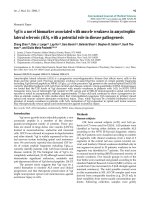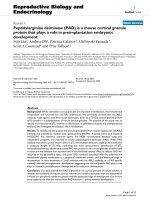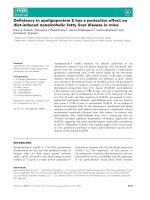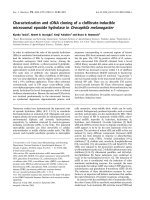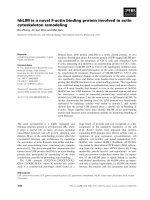microsomal epoxide hydrolase gene is a novel endogenous protectant against beta amyloid (1-42)-induced cognitive impairments in mice
Bạn đang xem bản rút gọn của tài liệu. Xem và tải ngay bản đầy đủ của tài liệu tại đây (855.8 KB, 54 trang )
Thesis for the Degree
of Master
Microsomal epoxide hydrolase gene is a
novel endogenous protectant against beta
amyloid (1-42)-induced cognitive
impairments in mice
by
Ngo Thi Ngoc Yen
Department of Pharmacy
Graduate school
Kangwon National University
August, 2011
Under the Guidance of
Professor Hyoung-Chun Kim
Microsomal epoxide hydrolase gene is a
novel endogenous protectant against beta
amyloid (1-42)-induced cognitive
impairments in mice
A THESIS
Submitted to the Graduate School of
Kangwon National University in Partial
Fulfillment of the Requirements
for the Degree of
Master of Pharmacy
by
Ngo Thi Ngoc Yen
Department of Pharmacy
August, 2011
Approved by Committee of the Graduate School of
Kangwon National University in Partial Fulfillment of the
Requirements for the Degree of
Master of Pharmacy
Ngo Thi Ngoc Yen
August, 2011
Thesis Committee;
Signature
(Chairman of Committee)
Signature
(Committeeman)
Signature
Jhoo, Jin-Hyeong
(Committeeman)
Kim, Hyoung-Chun
Shin, Eun-Joo
Microsomal epoxide hydrolase gene is a
novel endogenous protectant against beta
amyloid (1-42)-induced cognitive
impairments in mice
Ngo Thi Ngoc Yen
Department of Pharmacy
Graduate School, Kangwon National University
Abstract
Microsomal epoxide hydrolase (mEH) is one of critical
biotransformation enzymes in xenobiotic metabolism and
detoxification. In the early study, it was suggested that mEH may play a
modulatory role in pathogenesis of neurodegeneration in response to
environmental stress. To extend this understanding, the role of mEH in
the β amyloid (βA)-induced memory impairment was examined by
using mEH (-/-) mice and wild-type mice (WT). The cognitive
performance was assessed using Morris water maze, passive avoidance,
Y maze, novel object recognition test and water finding test after
intracerebroventricular (i.c.v) injection with βA (1-42). The result
showed that functional deficits of learning and memory in mEH (-/-)
groups were significant impaired compared to the WT. Decreases in the
acetylcholine (ACh) and choline acetyltransferase (ChAT) activity and
its expresstion, while increases in the acetylcholinesterase activity and
its expression were observed in the hippocampus of mEH (-/-) mice.
Consistently, effects of cyclohexene-oxide (CHO), a mEH inhibitor
were comparable to mEH (-/-) case. In addition, ChAT expression was
observed lower and AChE expression was higher in the APPswe/PS1
double transgenic mice. Unexpectedly, a significant increase in mEH
expression in the APPswe/PS1 double transgenic mice was observed in
the hippocampus and entorhinal cortex reflecting that compensative
induction of mEH to modulate of APPswe/PS1 gene. Combined, these
data suggests that mEH plays a neuroprotective role against cognitive
dysfunction induced by βA.
CONTENTS
I. Introduction 1
II. Material and methods 4
III. Results 13
IV. Discussion 31
V. References 36
List of figures
Fig. 1. Experimental schedule for measuring Aβ (1-42)-induced
cognitive impairment in the mEH (+/+)-, CHO-treated mEH (+/+)-, and
mEH (-/-)-mice. 18
Fig. 2. Effects of mEH gene deficiency and CHO (100mg/kg, i.p.) on
the water maze performance [hidden platform performance (A), probe
performance (B), and working memory performance (C)] after Aβ (1-42)
infusion. 20
Fig. 3. Effects of mEH gene deficiency and CHO (100mg/kg, i.p.) on
the Y-maze performance (A) and novel object recognition performance
(B after Aβ (1-42) infusion. 21
Fig. 4. Effects of mEH gene deficiency and CHO (100mg/kg, i.p.) on
the water finding performance (A) and passive avoidance performance
(B) after Aβ (1-42) infusion. 22
Fig. 5. Effects of mEH gene deficiency and CHO (100mg/kg, i.p.) on
the ACh level (A), activities of AChE (B) and ChAT (C) in the
hippocampus of mice after Aβ (1-42) infusion 23
Fig. 6. Effects of mEH gene deficiency on the gene expressions of
AchE (A) and ChAT (B) in the hippocampus of mice after Aβ (1-42)
infusion 24
Fig. 7. AchE expression in the hippocampus of mEH (+/+)-, and mEH
(-/-)-mice 25
Fig. 8. ChAT expression in the hippocampus of mEH (+/+)-, and mEH
(-/-)-mice 26
Fig. 9. AchE expression in the hippocampus of APPswe/PS1dE9 wild-
type and APPswe/PS1dE9 double transgenic mice 27
Fig. 10. ChAT expression in the hippocampus of APPswe/PS1dE9 wild-
type and APPswe/PS1dE9 double transgenic mice 28
Fig. 11. mEH expression in the hippocampus of APPswe/PS1dE9 wild-
type and APPswe/PS1dE9 double transgenic mice 29
Fig. 12. Flow chart describing current hypothesis on the roles of mEH
gene in the Aβ (1-42)-induced memory dysfunction 30
1
I. Introduction
Alzheimer's disease (AD) results from neurodegeneration characterized by
the deposition of senile plaques, development of neurofibrillary tangles,
inflammation, and neuronal loss. The senile places are composed of amyloid β-
peptide (Aβ), a 40-42 amino acid peptide fragment of the β-amyloid precursor
protein that plays an important role in the development of AD. It has been
demonstrated that a continuous intracerebroventricular (i.c.v) infusion of Aβ (1-42)
into the cerebral ventricle in rats results in learning and memory deficit (Estrin et
al., 1987a; Nitta et al., 1994). We have demonstrated that a single i.c.v. injection of
Aβ (1-42) causes the memory deficits in mice (Crystal et al., 1988; Jhoo et al.,
2004; Estrin et al., 1990).
It has been demonstrated that cholinergic system may play a crucial role in
modulating cognitive performance and learning memory processes (Winkler et al.,
1995) and deterioration of acetylcholine (ACh) function contribute to cognitive
decline, which might be associated with AD (Mesulam MM., 1996). Moreover, in
addition to significant neuronal cell loss within this brain region, evidence
implicating the basal forebrain cholinergic system in AD neuropathology comes
from numerous studies demonstrating decreases in choline acetyltransferase
(ChAT) activity (Bowen et al., 1976; Davies and Maloney, 1976; Perry et al., 1977;
Whitehouse et al., 1982), high affinity choline uptake (Rylett et al., 1983),
acetylcholine (ACh) release (Nilsson et al., 1986), and both nicotinic and
muscarinic ACh receptor binding (Araujo et al., 1988) in post-mortem brain tissue
of AD patients compared to non-pathological control brains. These evidences
2
implicate basal cholinergic system involvement in AD pathogenesis and its
accompanying cognitive deficits.
Microsomal epoxide hydrolase (mEH), a member of epoxide hydrolase (EH;
EC3.3.2.3) family, is one of several xenobiotic biotransformation enzymes. mEH
catalyzes the trans-addition of water to a broad range of epoxide subtracts (Fretland
and Omiecinski, 2000). mEH appears to have universal expression in all tissues
studies to date include the brain. mEH is thought to play a pivotal role in protection
against the toxicity of reactive epoxide intermediates, because metabolism of
epoxides by this enzyme results in the production of less reactive and less toxic
dihyrodiol intermediates of drug such as phenytoin and carbamazepine (Gaedigk et
al., 1994 ). Futhermore, mEH is involved in metabolism of compound-containing
epoxide induced cognitive impairment (Brashear et al., 1996; Estrin et al., 1987a;
Fennell and Brown, 2001). In contrast to this protective effect, it was suggested
that mEH is required for the metabolic activation of the potent carcinogen 7, 12-
dimethylbenz[a]anthracene (DMBA), a widely studied experimental prototype for
the polycylic aromatic hydrocarbon class of chemical carcinogens (Miyata et al.,
1999). We hypothesized that the induction of mEH in the striatal complex after
drug dependence is a compensative/protective response to low dose of
methamphetamine (Shin et al., 2009). However, mEH is involved in the MPTP-
induced doparminergic toxicology (Liu et al., 2008). Importantly, we reported an
increase in mEH expression in the hippocampus and the entorhinal and
transentorhinal cortex of AD cases, where severe pathology is usually found. mEH
colocalized with astrocytes but did not colocalize with amyloid plaques (Liu et al.,
2006). As a result, mEH remains to be charaterised whether mEH has an important
role in neuroprotection or neurodegeneration in response to environmental stress.
3
To achieve better understandings, we examined the role of mEH using
mEH (-/-) mice with mEH inhibitor-cyclohexene oxide (CHO) in the presence of
Aβ (1-42) exposure. In addition, we examined mEH expression in the
APPswe/PS1dE9 double transgenic mice. It was assessed Aβ (1-42)-induced
behavioral changes, ACh level, AChE and ChAT activity and their expressions in
the mEH (+/+)-, and mEH (-/-)-mice. This study suggested that mEH gene plays an
essential role to maintain cognitive function in the presence of Aβ (1-42)-induced
cognitive impairment.
4
II. Materials and methods
2.1. Animals and Drug treatments
All mice were treated in strict accordance with the NIH Guide for the
Humane Care and Use of Laboratory Animals. Male six month-old mEH (-/-)-mice
and male ten month-old APP/PS2dE9 double transgenic mice [B6C3-Tg (APPswe,
PSEN1De9) 85Dbo/J] were maintained on a 12:12 h light: dark cycle and fed ad
libitum. Also, they were adapted to these conditions for 2 weeks before the
experiment.
Aβ (42-1) and Aβ (1-42) were dissolved in 35% acetonitrile containing
0.1% trifluoroacetic acid. The Aβ (42-1) or Aβ (1-42) administration [400 pmol,
intracerebroventricular injection (i.c.v.)] was performed according to the procedure
established by Laursen and Belkap (Laursen and Belknap, 1986). Briefly, each
mouse was injected consciously at bregma with a 10 μl Hamilton microsyringe
fitted with a 26-gauge needle that was inserted to a depth of 2.4 mm. The injection
volume was 1.8 μl. The injection placement or needle track was visible and was
verified at the time of dissection.
CHO (100mg.kg, i.p) was dissolve in saline and administered to Aβ treated
mice for 11 consecutive days. The experimental schedule is shown in Fig. 1. CHO
or saline administration began 1 h before Aβ i.c.v injection and behavioral test. The
behavioral study began on day 3 after Aβ i.c.v. infusion, and carried out
sequentially. All mice were sacrificed immediately after behavioral tests. For
histological analysis, animals were anesthetized with 60% urethane and perfuse
5
transcardially with 200 ml of 50 mM phosphate buffered saline (PBS), followed by
50 ml of paraformaldehyde in PBS. The brains were fixed at 4
0
C for 24 h in the
same fixative and then cryoprotected in 30% sucrose. The brains were sectioned on
a horizontal sliding microstome into 35 μm transverse free-floading sections. For
western blot analysis and biochemical assay, the brains were quickly removed, the
hippocampus tissues were dissected out and samples were instantly frozen in liquid
nitrogen and kept at -79
0
C until needed for analysis.
2.2. Morris water test
The apparatus was circular water, 97 cm in diameter and 60 cm height.
During testing, the tank was filled with water (23 ± 2 °C) that was clouded with
powered milk. A transparent platform was set inside the tank and its top was
submerged 2 cm below the water surface in the center of one among the four
quadrants of the maze. The tank was located in a large room with many extramaze
cues that were constant throughout the study (Morris, 1984). The movements of the
animal in the tank were monitored with a video tracking system (EthoVision,
Noldus, The Netherlands).
2.2.1. Reference memory test
For each training trial, the mouse was put into the pool at one of the five
positions, the sequence of the positions being selected randomly. The platform was
located a constant position throughout the test period in the middle of one quadrant,
equidistant from the center and edge of the pool. In each training session, the
latency to escape on to the hidden platform was recorded. If the mouse found the
platform, it was allowed to remain there for 10 s and was then returned to its home
cage. If the mouse was unable to find the platform within 60 s, the training was
6
terminated and a maximum score of 60 s was assigned. Training was conducted for
four consecutive days, four times a day, from day 3 to 6 after the Aβ i.c.v. injection.
2.2.2. Probe test
On day 7 after Aβ i.c.v. injection, a double probe trial was conducted. The
platform was removed from the pool and each mouse was allowed to swim for 60 s
in the maze. The time spent by the animal searching for the missing platform on the
target quadrant was recorded.
2.2.3. Working memory (repeated acquisition) test
Working memory test was conducted three consecutive days from day 8 to
10 and consisted of five trials per day. The working memory test was procedurally
similar to reference memory test except that the platform location was changed
daily. The first trial of the day was an informative sample trial in which the mouse
was allowed to swim to the platform in its new location. Spatial working memory
was regarded as the mean escape latency of the second to fifth trials.
2.3. Y-maze test
The Y-maze was carried out on day 3 after Aβ (1-42) injection as described
previously (Maurice et al., 1994). Briefly, the maze was made of black painted
wood; each arm was 40 cm long, 12 cm high, 3 cm wide at the bottom and 10 cm
wide at the top. The arms converged at an equilateral triangular central area that
was 4 cm at its longest axis. Each mouse was placed at the end of one arm and
allowed to move freely through the maze during an 8 min session. The series of
arm entries were recorded visually. Alternation was defined as successive entry
into the three arms, on overlapping triplet sets. The alternation percentage was
7
calculated as the ratio of actual alternations to possible alternations (defined as the
total number of arm entries minus 2), multiplied by 100.
2.4. Novel object recognition test
This task, based on the spontaneous tendency of rodents to explore a novel
object more often than a familiar one (Ennaceur and Delacour, 1988) was
performed with a slight modification as described previously (Dodart et al., 2002).
A plastic chamber (35 cm×35 cm×35 cm) was used in low light condition during
the light phase of the light/dark cycle. The general procedure consisted of three
different phases: a habituation phase, an acquisition phase, and a retention phase.
On the 1st day (habituation phase), mice were individually subjected to a single
familiarization session of 10 min, during which they were introduced in the empty
arena, in order to become familiar with the apparatus. On the 2nd day (acquisition
phase) animals were subjected to a single 10 min session, during which floor-fixed
two objects (A and B) were placed in a symmetric position from the center of the
arena, 15 cm from each and 8 cm from the nearest wall. The two objects, made of
the same wooden material with the similar color and smell, were different in shape
but identical in size. Mice were allowed to explore the objects in the open field. A
preference index for each mouse was expressed as a ratio of the amount of time
spent exploring object A (TA ×100)/(TA + TB), where TA and TB are the time
spent on exploring object A and object B, respectively. On the 3rd day (retention
phase), mice were allowed to explore the open field in the presence of two objects:
the familiar object A and a novel object C in different shape but in similar color
and size (A and C). A recognition index, calculated for each mouse, was expressed
as the ratio (TC ×100)/(TA + TC), where TA and TC are the time spent during
retention phase on object A and object C, respectively. The time spent exploring
8
the object (nose pointing toward the object at a distance ≤ 1 cm) was recorded by
hand.
2.5. Water finding test
The water finding test was conducted to examine spatial attention (latent
learning), as described previously (Ennaceur and Delacour, 1988). The test
consisted of two trials; training trial (the first day) and retention trial (the second
day). Briefly, the apparatus consisted of an open field with an alcove. The floor of
the apparatus was divided into 15 identical squares for measuring locomotor
activity. A drinking tube was inserted into the center of the alcove ceiling with its
tip 3 cm (in the training trial) or 5 cm (in the retention trial) above the floor.
In the training trial, mice were placed individually into one corner of the
open field. Each mouse was allowed 3 min to explore the environment; the 3 min
were counted from the time the mouse started to explore. If mouse could not start
or find the drinking tube within 3 min, it was omitted from the retention trial. Mice
were immediately returned to their home cages after the training trial, and were
deprived of water for 24 h before the test trial.
In the test trial, mice were individually placed in the same corner of the
apparatus as that used during the training trial. The time until the mouse moved out
of the corner was measured as the starting latency. In addition, the time taken to
enter the alcove (entering latency) and the time between entering the alcove and
drinking the water (finding latency) were scored. The drinking latency consisted of
the sum of the entering and finding latencies.
2.6. Passive avoidance task
9
Passive avoidance was measured using a PACS-30 system (Columbus
Instruments, Ohio, USA), which consists of two-compartment shuttle chambers
with a constant current shock generator. On acquisition trial, each mouse was
placed into the start chamber, which remained darkened. After 20 s, the chamber
light was illuminated and the door was opened for mouse to move into the dark
chamber freely. Immediately it entered the dark chamber, the door was closed and
an inescapable scrambled electric shock (0.3 mA, 3 s, once) was delivered through
the floor grid. Then the mouse was returned to its home cage. Twenty-four hours
later, each mouse was again placed in the start chamber (retention trial). The
interval between the placement in the lighted chamber and the entry into the dark
chamber was measured as the step-through latency in both acquisition and retention
trials (maximum 300 s) (Yamada et al., 1999a; Yan et al., 2001).
2.7. Determination of acetylcholine (Ach) level and Acetylcholinesterase
(AChE) activity
Ach and AChE assays were performed as described previously (Zhou et al.,
1997; Mohanty et al., 1997). Hippocampus tissues were homogenated in ice-cold
20 mM sodium phosphate buffer (pH 7.4). These were centrifuged at 12,000 × g
for 30 min at 4
0
C. The supernatant was used for Ach measurement using
Amplex® Red Ach /AChE Assay Kit (A-12217) (Eugene, Oregon, USA).
According to the manufacturer’s instruction, a working solution, containing 400
μM Amplex Red reagent containing 2 U/ml HRP, 0.2 U/ml choline oxidase and 1
U/ml acetylcholinesterase, was prepared by adding 200 μl of Amplex Red reagent
stock solution, 100 μl of the HRP stock solution, 100 μl of the choline oxidase
stock solution and 100 μl of the acetylcholinesterase stock solutio to 9.5 ml of 1 X
Reaction Buffer. Reactions were begun by adding 100 μL of the working solution
10
to each microplate well containing 100 μL of the samples. Each reaction was
incubated for 1 h at room temperature and protected from light. The absorbance
was measured in a microplate reader (Molecular Devices, Synnyvale, CA, USA) at
the wavelength of 563 nm.
For AChE activity measurement, a working solution of 400 μM Amplex
Red reagent containing 2 U/ml HRP, 0.2 U/ml choline oxidase, and 100 μM
acetylcholine was prepared. Protein concentrations were determined using Quant-
iT
TM
Protein assay kit.
2.8. Determination of choline acetyltransferase (ChAT) activity
Five percent hippocampal homogenates were prepared in ice-cold 20mM
sodium phosphate buffer (pH 7.4), and kept frozen overnight at −20
0
C. These were
centrifuged at 12,000 × g for 1 h, at 4
0
C. The supernatant was assayed for ChAT
activity as described by Chao and Wolfgram (Chao and Wolfgram, 1972). The
reaction mixture contained 40 L of the homogenate and 10 l of each following
reagent: 0.5 M sodium phosphate buffer (pH 7.2), acetyl-CoA (6.2×10
−3
M),
choline chloride (1 M), neostigmine sulfate (7.6×10
−4
M), NaCl (3 M) and EDTA
(1.1 × 10
−3
M). The volume was adjusted with distilled water with the final volume
of 0.2 ml. The reaction mixture without the enzyme was preincubated in centrifuge
tubes in a water bath at 37
0
C for 5 min. The enzyme was then added and the tubes
were kept at 37
0
C for 20 min. The reaction was stopped by boiling the tubes in a
water bath for 2 min and adding 0.4 ml of oxygen-free distilled water. The
denatured protein was removed by centrifugation. 200 L of supernatant was added
to a tube containing 6 L of 4,4’-dithiopyridine (10
−3
M). The absorbency at 324
nm was measured employing a spectrophotometer after 15 min. One unit of
11
enzyme activity is defined as mol of reduced coenzyme formed per minute per
milligram protein. Protein was assayed as mentioned above.
2.9. Western blot analysis
The western blot assays was performed as described previously (Harlow
and Lan, 1999). Tissues were homogenized in lysis buffer, containing 200 mM Tris
HCl (pH 6.8), 1% SDS, 5 mM ethylene glycol tetraacetic acid, 5 mM
ethylenediaminetetraacetic acid, 10% glycerol, 1X phosphatase inhibitor cocktail I,
1X protease inhibitor cocktail. Lysate was centrifuged at 13,000 x g for 20 min
and supernatant fraction was used for Western blot analysis. Proteins (20-50 ug
/lane) were separated by 10% sodium dodecyl sulfate-polyacrylamide gel
electrophoresis and transferred onto the PVDF membranes. Following transfer, the
membranes were preincubated with 5% non-fat milk and incubated overnight at 4
0
C with primary antibody against -actin (1:50000, Sigma, St.Louis, MO, USA),
anti-AChE (1:500, Santa Cruz Biotechnology, Inc., Santa Cruz, CA), anti-ChAT
(1:500, Chemicon International, Inc. Temecula, CA). After incubation with primary
antibody, membranes were incubated with the HRP-conjugated anti-mouse IgG
(1:1000, Sigma), or HRP-conjugated anti-goat IgG (1:1000, Sigma) for 2 h.
Subsequently visualization was performed using enhanced chemiluminescence
system (ECL plus
®
, GE healthcare).
2. 10. Immunocytochemistry
The immunocytochemistry was performed as described previously (Kim et
al., 2000). Briefly, prior to incubation with the primary antibodies, sections were
preincubated with 0.3 % hydrogen peroxide in PBS for 30 min (to block
endogenous peroxidase activity), then in PBS containing 0.4 % Triton X-100 for 20
12
min and 1 % normal serum for 20 min. After 48 hr incubation with the primary
antibody at 4 °C, sections were incubated with the secondary biotinylated antisera
(1:1000 dilution; Vector, Brulingame, CA) for 1 h, washed, and immersed in
avidin-biotin-peroxidase complex (ABC Elite kit, Vector) for 1h. Sections were
always washed three times with PBS between each incubation step. 3,3’-
Diaminobenzidine (DAB) was used as the chromogen. The quantitative analyses
were performed using a computer-based image analysis system (Optimas version
6.2; Neurolucida program).
2.11. Statistics
The data were analyzed using a one-way ANOVA followed by Fischer’s
PLSD test or two-way ANOVA for repeated measures followed by Bonferroni’s
test. A significant level of less than 0.05 was accepted for comparisons.
13
III. Results
3.1. Effects of mEH gene deficiency and CHO (100mg/kg, i.p) on the water
maze performance after β amyloid (1-42) infusion in mice.
The changes in escape latency onto a hidden platform produced by training
trials are shown in Fig. 2A. The escape latencies of Aβ (1-42)-injected mice were
significantly delayed as compared to those of Aβ (42-1)-injected mice (p<0.01).
The mean escape latency of mEH (-/-)-mice is less efficency than the mEH (+/+)-
mice [p<0.01 vs. Aβ (42-1)-treated mEH (+/+)-mice; p<0.05 vs. Aβ (1-42)-treated
mEH (+/+)-mice]. Effect of CHO was parallel with that of mEH (-/-)-mice
[p<0.001 vs Aβ (42-1)- and Aβ (1-42)-treated mEH (+/+)-mice].
Probe test confirmed Aβ (1-42)-induced impairment in spatial reference
memory [p<0.01 vs. Aβ (42-1)-treated mEH (+/+)-mice, p<0.001 vs. Aβ (42-1)-
treated mEH (-/-)-mice, Fig. 2B]. mEH gene deficiency significantly decreased
performances in the mEH (-/-)-mice [p<0.05 vs Aβ (42-1) and Aβ (1-42)-treated
mEH (+/+)-mice]. These effects were more pronounced in the mEH (+/+)- mice
than in the CHO-treated mEH (+/+)-mice [p<0.001 vs Aβ (42-1) and Aβ (1-42)-
treated mEH (+/+)-mice].
Aβ (1–42)-induced impairment in spatial working memory, evaluated by
working memory task, was also more evident in the Aβ (42-1)-treated mice than
Aβ (1–42)-treated mice [p<0.001 vs. Aβ (42-1)-treated mEH (+/+)- and CHO-
treated mEH (+/+)-mice, p<0.01 vs. Aβ (42-1)-treated mEH (-/-)-mice]. mEH gene
deficiency significantly reduced Aβ (1–42)-induced impairment in spatial working
14
memory in the mEH (-/-)-mice [p<0.001 vs. Aβ (42-1)-treated mEH (+/+)-mice,
p<0.05 vs. Aβ (1-42)- treated mEH (+/+)-mice). The result of CHO-treated mice
was comparable to that of mEH (-/-)-mice [p<0.001 vs Aβ (42-1) and Aβ (1-42)-
treated mEH (+/+)-mice] (Fig.2C).
3.2. Effects of mEH gene deficiency and CHO (100mg/kg, i.p) on the Y maze
performance after β amyloid (1-42) infusion in mice.
The spontaneous alteration behaviour in the Aβ (1-42)-treated mice was
significantly decreased [p<0.01 vs. Aβ (42-1)-treated mEH (+/+)-mice, p<0.05 vs.
Aβ (42-1)-treated mEH (-/-)- and CHO-treated mEH (+/+)-mice]. Aβ (1-42)-
induced impairment in spontaneous alteration behavior was more evident in the
mEH (-/-)-mice [p<0.001 vs. Aβ (42-1)-and Aβ (1-42)-treated mEH (+/+)-mice].
Similarly, CHO-treated mEH (+/+)-mice showed near level of performance with
mEH (-/-)-mice after Aβ (1-42) administration [p<0.01 vs. Aβ (42-1)-and Aβ (1-
42)-treated mEH (+/+)-mice] (Fig. 3A).
3.3. Effects of mEH gene deficiency and CHO (100mg/kg, i.p) on the novel
object recognition performance after β amyloid (1-42) infusion in mice.
In training session, there was no significant change among groups (data not
shown), suggesting that there was no biased exploratory preference in the groups
and the mice did not show any inherent preference for each object. In the retention
session, Aβ (1-42)-induced impairment in visual recognition memory was more
significant in the mEH (-/-)- and CHO-treated mEH (+/+)-mice than mEH (+/+)-
mice [p<0.05 Aβ (42-1)-treated mEH (-/-)-mice vs. Aβ (42-1)-treated mEH (+/+)-
mice, p<0.05 Aβ (42-1)-treated CHO-treated mEH (+/+)-mice vs. Aβ (42-1)-
treated mEH (+/+)-mice] (Fig. 3B).
15
3.4. Effects of mEH gene deficiency and CHO (100mg/kg, i.p) on the water
finding performance after β amyloid (1-42) infusion in mice.
In the training trial, there was no significant effect on the number of
approaches to the water tube and ambulatory behaviour in the open field between
the groups (data not shown). In the test trial, Aβ (1-42) administration significantly
delayed finding and drinking in mEH (+/+)-[p<0.01 vs. Aβ (42-1) for finding-, and
drinking-latency, respectively], mEH (-/-)- [p<0.001 vs. Aβ (42-1) for both finding-
, and drinking-latency] and CHO-treated mEH (+/+)-mice [p<0.05 and p<0.01 vs.
Aβ (42-1) for finding-, and drinking-latency, respectively]. The mEH (-/-)- and
CHO-treated mEH (+/+)-mice treated with Aβ (1-42) were more vulnerable to
these impairments [p<0.001 in finding-, and drinking-latency, except p<0.01 CHO-
treated mEH (+/+)-mice vs mEH (+/+)-mice in finding-, and drinking-latency).
(Fig. 4A)
3.5. Effects of mEH gene deficiency and CHO (100mg/kg, i.p) on the passive
avoidance performance after β amyloid (1-42) infusion in mice.
In the acquisition trial, the step-through latencies did not differ among the
six groups. In the retention trial, the step-through latency in the retention trial was
significant decreased after Aβ (1-42) injection (p<0.05). mEH(-/-)-and CHO-
treated mEH (+/+)-mice were more susceptible to Aβ (1-42)-induced memory
impairment in this task (p<0.001) (Fig. 4B)
3.6. Effects of mEH gene deficiency and CHO (100mg/kg, i.p) on the level of
ACh, activities of AChE and ChAT after β amyloid (1-42) infusion in the
hippocampus of the mice.
16
The level of Ach, activity and expression of ChAT and AchE were
measured as the indices of cholinergic function. The decreases in level of Ach (Fig.
5A), activity of ChAT (Fig. 5B) were clearly observed in the hippocampus of
mEH(-/-)-and CHO-treated mEH (+/+)-mice compared to mEH (+/+)-mice
[p<0.001 mEH (-/-)-mice vs. mEH (+/+)-mice, p<0.001 Aβ (1-42)-treated CHO-
treated mEH (+/+)-mice vs. Aβ (1-42)-treated mEH (+/+)-mice, p<0.01 Aβ (42-1)-
treated CHO-treated mEH (+/+)-mice vs. Aβ (42-1)-treated mEH (+/+)-mice]. The
activity of AChE in the Aβ (1-42)-treated mice were significantly increased
[p<0.001 vs. Aβ (42-1)-treated mEH (-/-)-mice, p<0.01 vs. Aβ (42-1)-treated CHO-
treated mEH (+/+)- and mEH (+/+)-mice]. The change in the activity of AChE is
more pronounced in the mEH (-/-) mice [p<0.05 Aβ (1-42)-treated mEH (-/-)-mice
vs. Aβ (1-42)-treated mEH (+/+)-mice] (Fig. 5C)
3.7. Effects of mEH gene deficiency on the AChE and ChAT expression after β
amyloid (1-42) infusion in the hippocampus of the mEH (+/+)-and mEH (-/-)-
mice.
mEH (-/-)-mice resulted in significantly decrease in the ChAT expression
(p<0.05), while resulted in increase in the AChE expression (p<0.05) (Fig. 6). This
change was parallel with the result of immunocytochemistry in the hippocampus of
mEH (+/+)- and mEH (-/-)-mice (Fig. 7, Fig. 8).
3.8. AChE and ChAT expression change in the APPswe/PS1dE9 double
transgenic mice.
The protein expressions of AChE and ChAT were examined by
immunostaining in the APPswe/PS1dE9 wild-type and double transgenic mice. The
expression of ChAT in the APPswe/PS1dE9 wild-type was significant higher than
17
those in the APPswe/PS1dE9 double transgenic mice, the result was reversed in the
expression of AChE (Fig. 9, Fig. 10).
3.9. mEH expression was markly increased in APPswe/PS1dE9 double
transgenic mice.
The expression of hippocampal and cortical mEH activity from frozen
sections of APPswe/PS1dE9 double transgenic and wild-type mice is shown in (Fig.
11). As compare to APPswe/PS1dE9 wild-type, the mEH expression was markly
increased in APPswe/PS1dE9 double transgenic mice in both hippocampus and
cortex.

